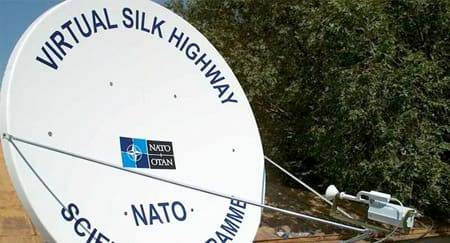Scientists and academics in Central Asia and the Southern Caucasus will soon be able to make substantially more effective use of the internet, as a result of the largest and most ambitious project to have been sponsored by the NATO Science Programme to date.
Called the Virtual Silk Highway - a reference to the Great Silk Road which used to link Europe to the Far East, promoting the exchange of both goods and of knowledge and ideas - the project is aimed at facilitating computer networking and internet access for the academic and scientific communities of eight countries in the Southern Caucasus and Central Asia. Internet connectivity is regarded as the most effective way to access and release the potential of the region's many highly educated scientists and researchers.
"This project is unique," says Walter Kaffenberger, the Science Programme's director for computer networking, "due to the number of countries involved, the fact that they span two geographic regions and the high level of investment."
In total, $2.5 million will be devoted to the project over four years. This represents 40 per cent of the Science Programme's computer-networking budget and is the largest investment in a single project in the programme's 44-year history.
The need for connectivity is particularly acute in the scientific and academic communities of Armenia, Azerbaijan and Georgia in the Southern Caucasus and Kazakhstan, the Kyrghyz Republic, Tajikistan, Turkmenistan and Uzbekistan in Central Asia. These countries lie on the fringes of the European internet arena and their level of development is such that they will not be able to afford fibre-optic connections in the foreseeable future.
The alternative is internet connection via satellite. However, this is expensive. As a result, the bandwidth available for the entire region's research and educational communities ranges from 64 to 384 kilobits/second (Kbps) per country. This compares with an average home internet connection in Western Europe of at least 56 Kbps, which is rising fast with the growth of broadband connections.
The Virtual Silk Highway will connect the scientific and academic communities of participating countries to the internet via a common satellite beam. Cost-effective, state-of-the-art satellite technology will increase the average bandwidth for each country to three megabits/second and allow access to the unused bandwidth of any other participating country. Modern data-caching techniques will collect all information requested from the web and make it available to other network users without having to go though the satellite connection, further increasing the network's efficiency.
The NATO grant will buy satellite bandwidth and finance the purchase and installation of nine satellite dishes using the so-called VSAT technology - eight small ones linked to a large dish in Hamburg, Germany, which will serve as the European hub. Other co-sponsors are contributing in kind.
Cisco Systems is donating equipment, worth around $400,000, which will be attached to each earth station. Deutsches Elektronen-Synchrotron, which has a long history of working with the particle physics communities in these countries, is providing services valued at $350,000 related to hosting the European hub and operating the network.
Deutsche Forschungs Netz will ensure that the network is connected to the European Union's huge pan-European Gigabit research network, GEANT, which in turn is linked up to other research networks around the world — a service valued at $125,000.
GEANT is not charging for international bandwidth and EurasiaSat is providing bandwidth at special tariffs. The network is expected to be fully up-and-running by October 2002.
"The priority now," says Dr Kaffenberger, "is to ensure that this unique project is viable and self-sustaining in the long-term, once NATO funding runs out in 2004. Proper project-management structures and new sources of finance will be essential."
Since NATO's Science Programme is only able to finance infrastructure construction, EU funding is now being sought to help set up appropriate project-management structures and procedures, with the aim of progressively transferring as much management and know-how as possible to the participating countries.
NATO is supporting the establishment of National Research and Education Networks (NRENs) in each participating country with a mandate to take care of national networking needs of their educational and scientific establishments. Such NRENs could take on the role of raising funds nationally.
Contacts are also being made with organisations that may be interested in paying a fee to use the network system. These include the United Nations Development Programme, which is active in developing the connectivity of governments and non-governmental organisations in the region, and the Soros Foundation, which seeks to promote democracy through connectivity.
During the past decade, the NATO Science Programme has sought to sustain the scientific communities of Eastern Europe and the former Soviet Union, which have seen their budgets slashed in the wake of the collapse of the Eastern bloc. Since 1994, one way to further this aim has been to promote local networking between academic and scientific institutions by helping set up the appropriate infrastructure and organising workshops. Once local networks and infrastructure were in place, it was important to ensure basic and reliable internet connectivity to facilitate research and contacts with the global scientific community.

